In this article, we’ll take a look at some of the best DJ mixer options for beginners, offering product reviews for a variety of aspiring DJs, and a range of models to suit a variety of budgets and brand loyalties.
This curated collection is our selection of the best beginner gear, and we hope you’ll find what you’re looking for.
Best DJ Mixer for Beginners
1. Behringer DDM4000 Digital DJ Mixer
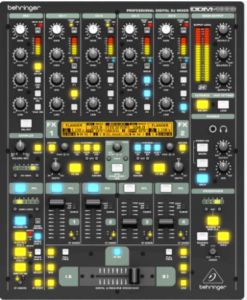
With so many different formats, features, and brand names, choosing your first DJ mixer can be a daunting task for a novice DJ.
Instead of spending thousands of dollars on a top-of-the-line club-standard mixer, most novice DJs are looking for something that offers features similar to those of flagship models at a lower price point. Enter the Behringer DDM4000.
The DDM4000 is not a clean, simple mixer. In fact, the first thing you’ll notice is that it has more buttons and knobs than a fighter jet.
That’s because the DDM4000 tries to do something that only a handful of mixers have managed to do: provide all the features of a top-of-the-line mixer at an entry-level price.
Among the many features of the DDM4000 are four channels, sample recording and playback, individual fader curve adjustment, lots of LED backlighting (good for visibility), MIDI in/out, and a wide range of sound FX.
Overall, the Behringer DDM4000 is a fantastic choice for anyone looking to get into the world of DJing with more than just two decks and a crossfader.
Packed with all the features you could want and at a competitive price, the DDM4000 would make a great first mixer for novice DJs, while still remaining useful as a full-featured backup for veterans.
You probably won’t be taking this mixer to your headlining festival sets, but it can teach you what you need to get there.
2. Pioneer DJ DJM-250MK2
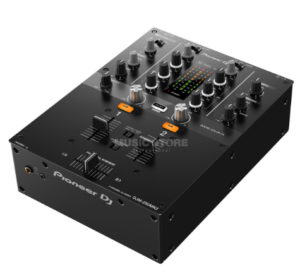
Whether you’re just starting out on your DJ journey or you’re already playing but want a simple home setup for practice.
The 2-channel Pioneer DJ DJM-250MK2 has all the basics (including a great crossfader and per-channel filters) and the familiar Pioneer DJ club look and feel, but it’s also an audio interface that works with Rekordbox DJ software (unlocked) and Rekordbox DVS, and lets you scratch with your turntables.
With pro XLR outputs and both mic and auxiliary inputs, it’s easy to use even in the most minimal pro DJ environment. It’s a great, basic all-rounder.
3. Reloop RMX-95
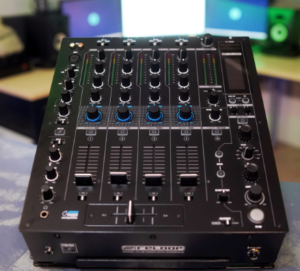
The Reloop RMX-95 stands out as a great choice for DJs looking for a high-performance club mixer with premium sound, advanced connectivity options, and full integration with djay PRO AI software.
The 24-bit dual 10 In/Out USB audio interface and USB hub provide excellent sound quality and flexible connectivity, allowing for seamless transitions between DJs and maximum setup flexibility for a single club night.
The mixer’s digital architecture also allows it to be converted into an individually mappable MIDI controller, further enhancing its versatility.
With four CD, two line, two phono inputs, separate mic channels, and a range of output options including master, booth and recording outputs, the RMX-95 offers extensive connectivity for a variety of setups.
In addition, integration with djay PRO AI software, including the groundbreaking Neural Mix feature, takes the DJ experience to a whole new level.
The mixer’s sleek black metal surface and solid construction ensure durability even after heavy club use, making it a reliable and innovative choice for the modern DJ.
4. Numark M2
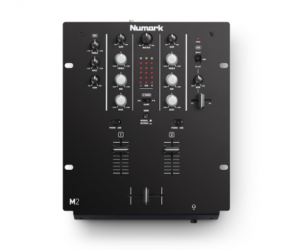
Numark also produces impressive mid- and pro-level DJ gear, but has long been a preferred choice at the entry-level of the market.
The M2 is the most basic of the DJ mixers. It has two channels, each of which can be switched between line and phono inputs for connecting CDJs or turntables.
Each channel has a fader, a separate gain knob, 3-band EQ, and a crossfader for blending/cutting between the two channels.
There’s also a mic channel with its own EQ and gain, and a headphone output with crossfader-controlled cueing.
The M2 has everything you need to learn the basics of mixing or scratching and is a solid choice for a first setup.
Its biggest drawback is its lack of expandability when you want more. There are no effects, no way to integrate external effects, and no digital compatibility to allow for more creative use as technology advances.
The EQ and gain controls lack the subtlety and responsiveness of high-end mixers, but the overall build quality is solid and durable.
5. Allen & Heath Xone:23
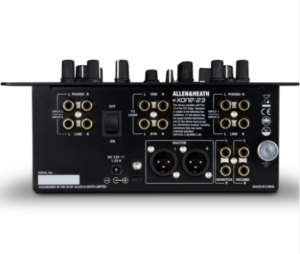
Allen & Heath and Pioneer are sworn enemies in the DJ gear camp. While Pioneer has the edge in popularity, Allen & Heath wins in sound quality.
One of the most interesting and well-reviewed intro-level DJ mixers is the Allen & Heath Xone:23 2-channel mixer (FYI Xone is pronounced like “zone”).
It’s surprisingly affordable for such a high-quality piece of gear, costing hundreds of dollars less than the Pioneer DJM-350.
When it comes to sound quality, Allen & Heath has something special.
While all DJ mixers sound pretty much the same to the average user, audiophiles will notice that Allen & Heath is a cut above the rest when it comes to sheer sound quality, and that’s certainly true of the Xone:23.
While it doesn’t record directly to USB like the DJM-350, it makes up for it with flexible I/O and balanced master outs.
The crossfader isn’t ideal for scratching, but it’s replaceable. Also, the LED meters only display the master, not the individual channels (which seems to be a deal-breaker for some DJs).
One of the biggest advantages of this DJ mixer over its Pioneer competitors is its much lower price tag. It’s amazing that a mixer of this quality can cost this much.
If you can live with the aforementioned drawbacks, this is a versatile and reliable 2-channel DJ mixer that’s perfect for both practice and gigging.
6. PLAYdifferently Model 1
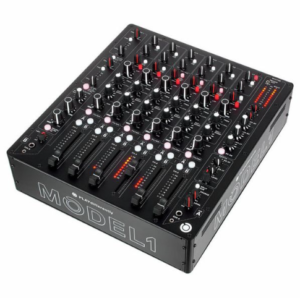
The PLAYdifferently Model 1 is fully analog, with features designed to appeal to purist electronic DJs like Richie Hawtin.
In some ways, it’s similar to the Pioneer DJ DJM-V10 (see above), in that the mixer is designed for endless sound shaping and to work well and flexibly with other gear.
However, being 100% analog, it’s very different from the Pioneer models in other ways, and you probably already know which one you like better.
There’s also the Model 1.4, which is identical to the Model 1, except that it has four channels instead of six. There’s no other mixer like this, which means it’s perfect for its niche.
7. Pioneer DJ DJM-A9
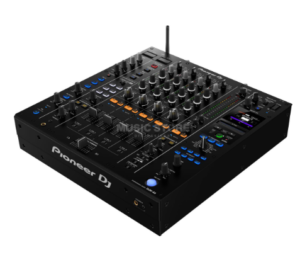
The ultimate club mixer that’s about to hit bars and clubs around the world is Pioneer’s flagship (industry standard) 4-channel DJM-A9!
Featuring the same familiar layout as the (now aging) DJM-900NXS2, the new 4-channel unit is a huge upgrade over its predecessor, offering significantly better sound quality thanks to 32-bit converters, modernized connectivity options, new FX, and more.
More specifically, some notable features include a ‘center lock’ on the Sound Color FX knobs (when turned on, the knobs won’t go past 12 o’clock in the opposite direction), a better display screen with more customization options, two headphone outputs with dedicated cueing (great for continuation and DJ swapping), a vastly improved mic setup, and Bluetooth pairing.
The layout has also been tweaked for a better user experience, with the DJM-A9 offering more space around the EQ knobs.
Additionally, the channel faders and Magvel crossfader have been redesigned using better-quality materials.
For software, there’s full support for Pioneer’s Rekordbox and Serato DJ Pro (Serato requires a separate license), as well as compatibility with the ‘Stagehand’ app, which lets you wirelessly connect an iPad to your venue via WiFi and monitor the mixer’s activity.
8. Xtreme Acoustics XAMX42 4-Channel
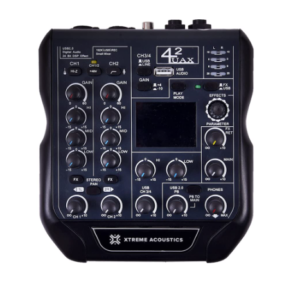
The Xtreme Acoustics XAMX42 4-Channel audio mixer interface is the perfect tool for aspiring DJs and beginners alike.
Featuring a user-friendly design and advanced features, this mixer is ideal for studio recording, YouTube content creation, DJ mixing, and even karaoke singing.
The 192kHz sampling rate ensures high-quality sound, and the 2-track recording function lets you capture your mixes with ease.
The MP3 input lets you seamlessly integrate your favorite tracks, and the 24-bit DSP FX processor adds professional effects to your mixes.
Step confidently into the world of DJing with the Xtreme Acoustics XAMX42 audio mixer interface.
FAQ
Which DJ Mixer is Best?
There are a few factors to consider when choosing a DJ mixer. First, you should consider the mixer features that are important to you.
This can include the number of channels, the variety of effects, and compatibility with digital platforms. It’s also important to evaluate your budget options and find a mixer that fits your price range.
You should also consider the mixer’s compatibility with your existing equipment or software.
Another important factor to consider is the mixing technology you use or plan to use. Different mixers may have different features that can enhance your mixing style.
For example, some mixers may have built-in effects or looping capabilities that can help you create unique, smooth transitions between songs.
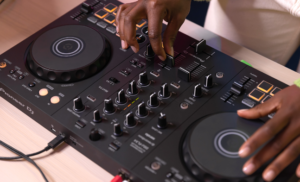
What’s the difference between a DJ mixer and a DJ controller?
A DJ controller is an all-in-one device with a built-in mixer, but in other setups, the mixer is a separate device placed in the middle of two music sources (decks).
These are usually two turntables or two media players/CDJs. Either way, they both provide the same functionality.
What are the best brands for DJs?
When it comes to DJs, some of the top brands for DJ mixers include Pioneer, Allen & Heath, Rane, Numark, and Denon.
These brands offer a variety of mixers to suit a variety of budgets and preferences.
Popular features to look for include digital compatibility, a variety of effects, and a user-friendly interface. Each brand offers affordable options and high-quality mixers to suit a variety of DJ styles.
Ultimately, it all comes down to your specific needs and what features are most important to you.
How do I connect my DJ mixer to my speakers?
Connect your DJ mixer to your speakers using RCA or XLR cables. Connect one end to the outputs of the mixer to match the left and right channels, and the other end to the corresponding inputs on your speakers.
Make sure to check the proper power and volume settings on both devices for optimal sound quality.
